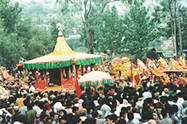
 After months of hardwork in the fields and orchards, there comes
the month of Phalgun (mid February to mid March) that marks the
beginning of fairs and festivals in the valley. These fairs
After months of hardwork in the fields and orchards, there comes
the month of Phalgun (mid February to mid March) that marks the
beginning of fairs and festivals in the valley. These fairs  and festivals
and festivals  are
mostly held to celebrate the victory of good over the evil or
recall any episode related to the deities. They celebrate the
rich cultural and traditional inheritance of the people, which
they have been maintaining since epochs.
are
mostly held to celebrate the victory of good over the evil or
recall any episode related to the deities. They celebrate the
rich cultural and traditional inheritance of the people, which
they have been maintaining since epochs.
Dusshera is a unique fair held every year in October. It is
a beautiful amalgam of history, rich culture and customs. Unlike
other regions of India here effigies of Ravana, Meghnath and Kumbhakarana
are not burnt. This is how victory of good over evil is depicted.
Kullu Dusshera starts usually on the day it ends in the rest of
the country.
 It
all started back in 1637 A. D. when Raja Jagat Singh was the ruler
of the Valley. One day he came to know that a peasant Durga Dutt
of village Tipri owned beautiful pearls, which the Raja wanted
to obtain. Durga Dutt tried to convince the Raja by all means
that the information was wrong and that he owned no pearls, but
all his pleas were in vain.
It
all started back in 1637 A. D. when Raja Jagat Singh was the ruler
of the Valley. One day he came to know that a peasant Durga Dutt
of village Tipri owned beautiful pearls, which the Raja wanted
to obtain. Durga Dutt tried to convince the Raja by all means
that the information was wrong and that he owned no pearls, but
all his pleas were in vain.
The Raja gave him a last chance. Durga Dutt got so scared that
he burnt down his own family and house and cursed the Raja for
his cruelty. His curse resulted in Raja's leprosy and as he realized
the fact he felt guilty.
Kishan Das known as Fuhari Baba advised him to install the famous
idol of Lord Raghunathji to get rid of the curse of the peasant.
He sent Damodar Dass to steal the idol from Tret Nath Temple of
Ayodhya who finally brought it from there in July 1651 A. D. After
installing the idol he drank Charnamrit of the idol for several
days and was in due course cured. He devoted his kingdom and life
for the lord and from then onwards Dusshera started being celebrated
with great splendor. Thus on the first fortnight of Ashwin month
(mid September to mid October), the Raja invites all the 365 Gods
and Goddesses of the Valley to Dhalpur to perform a Yagna in Raghunathji's
honor.
On the first day of Dusshera Goddess Hadimba of Manali comes
down to Kullu. She is the Goddess of the royal family of Kullu.
At the entrance of Kullu the Royal Stick welcomes her and escorts
her to the Palace where the royal family awaits her at the entrance
of the Palace. Thereafter they enter the Palace only when goddess
Hadimba calls them inside. After blessing the royal family she
comes to Dhalpur.
The idol of Raghunathji is saddled around Hadimba and placed
in a Ratha (chariot) adorned beautifully. Then they wait for the
signal from Mata Bhekhli, which is given from top of the hill.
Next the Ratha is pulled with the help of ropes from its original
place to another spot where it stays for the next six days. The
male members of the royal family leave the palace and stay in
the Dusshera ground.

More than one hundred gods and goddesses mounted on colorful
palanquins participate in this procession. The ceremony feels
as if the doors of heaven have been opened and the gods have come
down to the earth to rejoice.
On the sixth day of the festival, the assembly of Gods takes
place, which is called 'Mohalla'. It is an impressive and a rare
sight to see the multihued palanquins of Gods around the camp
of Raghunathji. People usually dance the whole night through.
On the last day the Ratha is again pulled to the banks of river
Beas where a pile of thorn bushes is set on fire to depict the
burning of Lanka. Some animals are sacrificed and the Ratha is
brought back to its original place. Raghunathji is taken back
to the temple in Raghunathpur. Thus world famous Dusshera comes
to an end in a dignified way, full of festivities and grandeur.
The Dhalpur grounds are full of vendors who come from different
parts of the country to sell their goods. Various government organizations
and private agencies also set up various exhibitions concerning
their line of work. At night thousands of people witness the International
Cultural Festival in Kala Kendra (an open-air theatre).
Kullu Dusshera ends all the fairs and festivals celebrated in
the valley.

